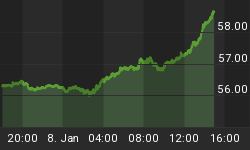In this Observation, we examine some historical trends of the stock market. It is an attempt to use many of the charts available on our web site to build a POSITIVE case for the stock market from what history might be telling us.
We begin by looking at the decennial pattern.

Chart 1 Notes:
- This chart shows the average percentage change of the Dow Jones Industrials for each year of the decade since 1886.
- Years ending in 5 have demonstrated the BEST average performance for the period 1886 to 2003.
The following chart breaks out the respective years ending in 5 for the Dow Jones Industrial Average.

Chart 2 Notes:
- The range of returns spans 1.68% in 1895 to 81.66% in 1915 with an average return of 31.62% for the eleven observations. If we remove the high and low observations, the average for the nine remaining observations is 29.39%
- Five of our observations are the first year of the presidential cycle. Those years are 1905, 1925, 1945, 1965 and 1985. In each case, the sitting president was returned to office. The average for those five observations is 26.68%.
The following five charts show the daily Dow Jones Industrial Average for each of the first years of the presidential cycle mentioned above: Theodore Roosevelt - 1905, Calvin Coolidge - 1925, Franklin Roosevelt - 1945, Lyndon Johnson - 1965 and Ronald Reagan - 1985.





In our June 6, 2004 Observation, we pointed out "An Interesting Long-term Stock Market Cycle." The following chart updates the last chart of that Observation.

The historical record suggests to us that, if history repeats, the "Doom and Gloom Society" will be put on hold until 2006. Yes, we respect many of their arguments and do appreciate the many problems the economy faces. We just might have to complete the CYCLICAL bull market currently underway before the SECULAR bear market resumes. The following charts are examples of what we "see."
The S&P 500 Equal Weighted Index has broken to NEW ALL-TIME HIGHS. Yes, how an index is calculated does make a difference. Below the large capitalization "generals" in the S&P 500 index, the "privates" in the index have been doing very well, thank you.

Further confirmation of how well the "privates" have been doing vs. the "generals" is exemplified by the following chart. We have re-based both the Equal Weighted Index and the Capitalization Weighted Index to 100 at the end of 1989, and the chart shows how well the "privates" have been doing since 9-11.

The next step down from the S&P 500 is the S&P 400 Mid Cap. The following chart shows that the S&P 400 MidCap has ALSO broken to NEW ALL-TIME HIGHS.

Again confirmation of how well the "privates" have been doing vs. the "generals" is exemplified by the following chart. We have re-based both the MidCap Index and the Capitalization Weighted Index to 100 at the end of 1989, and the chart shows how well the "privates" have been doing since 1999.

Dow Theory suggests that we must not just look at "Industrials," but also the movement of what the "Industrials" are producing. The following chart shows the Dow Jones Transportation Average since 2000. NEW HIGHS since 2000, even with airlines included! (See our September 18 Observation - "Leading the Way" - The Forgotten Indices)

Wrapping it all up:
- The historical record strongly suggests that 2005 could be an "up year" for the stock market.
- Did we have a "stock market bubble" from 1995 to 2000, complete with excesses we probably have not seen since the late 1920's, yes!
- Should we join the "Doom and Gloom Society?" No! Wait until 2006.
















